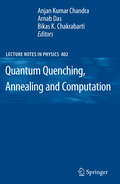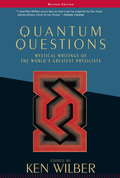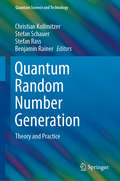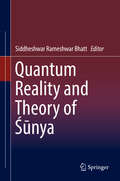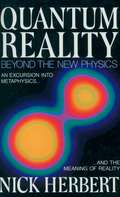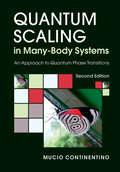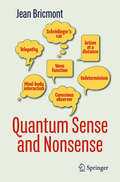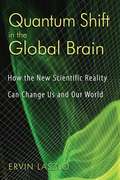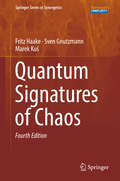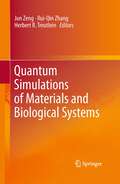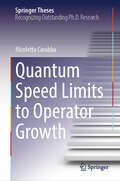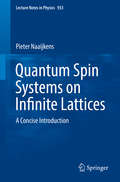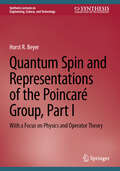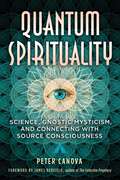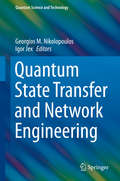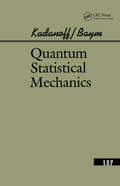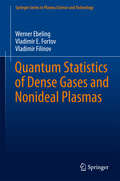- Table View
- List View
Quantum Processes, Systems, and Information
by Benjamin Schumacher Michael D. WestmorelandA new and exciting approach to the basics of quantum theory, this undergraduate textbook contains extensive discussions of conceptual puzzles and over 800 exercises and problems. Beginning with three elementary 'qubit' systems, the book develops the formalism of quantum theory, addresses questions of measurement and distinguishability, and explores the dynamics of quantum systems. In addition to the standard topics covered in other textbooks, it also covers communication and measurement, quantum entanglement, entropy and thermodynamics, and quantum information processing. This textbook gives a broad view of quantum theory by emphasizing dynamical evolution, and exploring conceptual and foundational issues. It focuses on contemporary topics, including measurement, time evolution, open systems, quantum entanglement, and the role of information.
Quantum Quenching, Annealing and Computation
by Bikas K. Chakrabarti Arnab Das Anjan Kumar ChandraThe process of realizing the ground state of some typical (frustrated) quantum many-body systems, starting from the 'disordered' or excited states, can formally be mapped onto the search of solutions for computationally hard problems. The dynamics through quantum critical points are especially crucial in the context of such computational optimization problems and have been investigated intensively in recent times. Several successful methods are now well-established, and this volume compiles a collection of introductory reviews on such developments and related aspects. Written by well known experts, these lectures concentrate on quantum phase transitions and their dynamics as the transition or critical points are crossed. Both the quenching and annealing dynamics are extensively covered. The style has been kept as tutorial as possible in order to make this volume a suitable reference for young researchers joining this exciting and burgeoning field of research.
Quantum Questions: Mystical Writings of the World's Great Physicists
by Ken WilberHere is a collection of writings that bridges the gap between science and religion. Quantum Questions collects the mystical writings of each of the major physicists involved in the discovery of quantum physics and relativity, including Albert Einstein, Werner Heisenberg, and Max Planck. The selections are written in nontechnical language and will be of interest to scientists and nonscientists alike.
Quantum Radiation in Ultra-Intense Laser Pulses
by K. Felix MackenrothScientific advances and several technical breakthroughs have led to a remarkable increase in available laser intensities over the past decades. In available ultra-intense laser fields, photon fluxes may become so high that free charge carriers interact coherently with several of the field's photons. In this thesis such nonlinear interactions are investigated for the prime example of radiation emission by electrons scattered from intense laser pulses of arbitrary temporal structure. To this end, nonlinear quantum field theory is employed taking the interaction with the laser into account exactly. After an in-depth introduction to classical particle dynamics as well as quantum field theory in nonlinearly intense laser fields the emission of one and two photons is explicitly analyzed. The results are then translated to viable technical applications, such as a scheme for the determination of the carrier-envelope phase of ultra-intense laser pulses and a proposal for detecting the strongly suppressed two-photon signal.
Quantum Random Number Generation: Theory and Practice (Quantum Science and Technology)
by Stefan Rass Stefan Schauer Christian Kollmitzer Benjamin RainerThis book provides an overview of state-of-the-art implementations of quantum random number generators (QRNGs), and especially examines their relation to classical statistical randomness models and numerical techniques for computing random numbers. The reader – who ideally has a background in classical statistics, computer science, or cryptography – is introduced to the world of quantum bits step by step, and explicit relations between QRNGs and their classical counterparts are identified along the way. Random number generation is a major pillar of cryptography. Capitalizing on the randomness inherent in quantum phenomena is a rapidly evolving branch of quantum cryptography with countless applications for the future. The value of quantum randomness for cryptographic purposes is empirically demonstrated in statistical evaluations of QRNGs’ performance compared to classical techniques for true and pseudorandom number generation. The book then provides an overview of technical implementations of QRNGs, before a concluding discussion of major achievements and remaining obstacles in the field rounds out the coverage, while also opening the door for future research directions.
Quantum Reality and Theory of Śūnya
by Siddheshwar Rameshwar BhattThe book deals with expounding the nature of Reality as it is understood in contemporary times in Quantum Physics. It also explains the classical Indian theory of Śūnya in its diverse facets. Thereafter it undertakes comparison between the two which is an area of great topical interest. It is a cross-disciplinary study by erudite Indian and western scholars between traditional Indian knowledge system and contemporary researches in Physical sciences. It points out how the theory of ‘Śūnyatā has many seminal ideas and theories in common with contemporary Quantum Physics. The learned authors have tried to dissolve the “mysteries” of Quantum Physics and resolved its “weird paradoxes” with the help of theory of Śūnyatā. The issue of non-separability or entanglement has been approached with the help of the Buddhist theory of Pratītyasamutpāda. The paradoxical situation of “wave-particle duality” has been explained with the help of Upaniṣadic theory of complementarity of the two opposites. The measurement problem represented by “Schrodinger’s cat” has been dealt with by resorting to two forms of the calculation of probabilities. Some writers have argued for Śūnyatā-like non-essentialist position to understand quantum reality. To make sense of quantum theory some papers provide a happy symbiosis of technical understanding and personal meditative experience by drawing multifarious parallels. This book will be of interest to philosophically inclined physicists and philosophers with interest in quantum mechanics.
Quantum Reality: Beyond the New Physics
by Nick HerbertThis clearly explained layman's introduction to quantum physics is an accessible excursion into metaphysics and the meaning of reality. Herbert exposes the quantum world and the scientific and philosophical controversy about its interpretation.From the Trade Paperback edition.
Quantum Reality: Theory and Philosophy
by Jonathan AlldayAs probably the most successful scientific theory ever created, quantum theory has profoundly changed our view of the world and extended the limits of our knowledge, impacting both the theoretical interpretation of a tremendous range of phenomena and the practical development of a host of technological breakthroughs. Yet for all its success, quantum theory remains utterly baffling. Quantum Reality: Theory and Philosophy, Second Edition cuts through much of the confusion to provide readers with an exploration of quantum theory that is as authoritatively comprehensive as it is intriguingly comprehensible. The book has been fully updated throughout to include the latest results in quantum entanglement, the theory and practical applications of quantum computing, quantum cosmology and quantum gravity. Needing little more than a school level physics and mathematics background, this volume requires only an interest in understanding how quantum theory came to be and the myriad ways it both explains how our universe functions and extends the reach of human knowledge. Written by well-known physics author and teacher Dr. Jonathan Allday, this highly engaging work: • Presents a thorough grounding in the theoretical machinery of quantum physics • Offers a whistle-stop tour through the early part of the 20th century when the founding fathers of quantum theory forever altered the frontiers of human thought • Provides an example-filled interpretation of the theory, its applications, and its pinnacle in quantum field theory (QFT), so crucial in shaping ideas about the nature of reality • Separates fact from speculation regarding quantum physics’ ability to provide a starting point for philosophical queries into ultimate understanding and the limits of science The world beneath the one that we experience with our senses is profoundly mysterious, and while we may never completely unravel that mystery, quantum theory allows us to come closer than ever to understanding where the science leaves off and the mystery begins. Quantum Reality: Theory and Philosophy, Second Edition makes that understanding accessible to anyone possessing a quest for knowledge and a sense of awe.
Quantum Scaling In Many-body Systems
by Mucio ContinentinoThis book on quantum phase transitions has been written by one of the pioneers in the application of scaling ideas to many-body systems OCo a new and exciting subject that has relevance to many areas of condensed matter and theoretical physics. One of the few books on the subject, it emphasizes strongly correlated electronic systems. Although dealing with complex problems in statistical mechanics, it does not lose sight of the experiments and the actual physical systems which motivate the theoretical work. The book starts by presenting the scaling theory of quantum critical phenomena. Critical exponents for different systems are calculated using both the momentum space and real space renormalization group approaches. The former is developed without the use of Feynman diagrams, allowing nonspecialists to fully appreciate the underlying physics of this method. The case of heavy fermions as an example of systems close to a zero temperature phase transition is presented and discussed in detail. This is also the case of non-Fermi liquid behavior associated with a quantum critical point. MetalOCoinsulator transitions are discussed within the scaling approach. The book ends with a discussion on first order quantum phase transitions, in particular those which occur due to a fluctuation-induced mechanism. Contents: Scaling Theory of Quantum Critical Phenomena; Landau and Gaussian Theories; Renormalization Group: The A-Expansion; Quantum Phase Transitions; Real Space Renormalization Group Approach; Heavy Fermions; A Microscopic Model for Heavy Fermions; MetalOCoInsulator Transitions; Density-Driven MetalOCoInsulator Transitions; Mott Transitions; The Nonlinear Sigma Model; Fluctuation-Induced Quantum Phase Transitions. Readership: Graduate students, lecturers and researchers in condensed matter physics. "
Quantum Science of Psychedelics: The Pineal Gland, Multidimensional Reality, and Mayan Cosmology
by Carl Johan CallemanA groundbreaking exploration of how psychedelics and quantum science are vital to understanding the evolution of consciousness and reality • Explains why altered states of consciousness exist, how they work, and why psychedelics have the effects that they do • Describes how quantum waves, rather than the DNA molecule, have been the driving force behind biological and historical evolution • Explains how psychedelics interact with the human mind to create altered states that may further the continued evolution of consciousness In this groundbreaking book, Carl Johan Calleman reveals the quantum science of the Maya, a science lost to the modern world that explains the phenomenology of psychedelics and altered states of consciousness. The ancient Maya had a sophisticated understanding of the multidimensional nature of reality and the forces that drive the evolution of consciousness. Calleman explains how quantum waves, illustrated by the Mayan Calendar, emanate from the center of the universe and activate new phases in the evolution of consciousness through holographic resonance, which alters the dualities of the human mind. For example, the 5th Wave, which dominated in Paleolithic times and evolved human consciousness above that of animals, brought a chaotic floating state reminiscent of the psychedelic or shamanic state, and the recent 8th Wave brought the digital revolution. The 9th Wave, which began in 2011, offers the potential for individual development of higher consciousness and healing if we can synchronize ourselves with its positive holograms. This multidimensional perspective explains why altered states of consciousness exist and how they work. Calleman describes the role of the pineal gland for the human mind, how it controls our state of consciousness and how it can connect us to the cosmic Tree of Life. He shows that the mind is a &“reducing valve&” that normally limits our experience of cosmic consciousness but that this can be reversed through altered states. As Calleman concludes, psychedelics like ayahuasca and DMT not only give rise to extraordinary mystical and cosmic experiences and enable access to healing states, but they also are important for harmoniously synchronizing humanity with the 9th Wave to further the evolution of consciousness.
Quantum Science: The Frontier of Physics and Chemistry
by Taku OnishiThis book focuses on recent topics of quantum science in both physics and chemistry. Until now, quantum science has not been fully discussed from the interdisciplinary vantage points of both physics and chemistry. This book, however, is written not only for theoretical physicists and chemists, but also for experimentalists in the fields of physical chemistry and condensed matter physics, as collaboration and interplay between construction of quantum theory, and experimentation has become more important. Tips for starting new types of research projects will be found in an understanding of cutting-edge quantum science. In Part I, quantum electronic structures are explained in cases of strongly correlated copper oxides and heavy elements. In Part II, quantum molecular dynamics is investigated by computational approaches and molecular beam experiments. In Part III, after lithium problem in big bang nucleosynthesis scenario is considered using supersymmetric standard model, quantum theories in atomic and molecular systems are reviewed. Finally, in Part IV, the development of quantum computational method is introduced.
Quantum Sense and Nonsense
by Jean BricmontPermeated by the author's delightful humor, this little book explains, with nearly no mathematics, the main conceptual issues associated with quantum mechanics: The issue of determinism. Does quantum mechanics signify the end of a deterministic word-view? The role of the human subject or of the "observer" in science. Since Copernicus, science has increasingly tended to dethrone Man from his formerly held special position in the Universe. But quantum mechanics, with its emphasis on the notion of observation, may once more have given a central role to the human subject. The issue of locality. Does quantum mechanics imply that instantaneous actions at a distance exist in Nature? In these pages the author offers a variety of views and answers - bad as well as good - to these questions. The reader will be both entertained and enlightened by Jean Bricmont's clear and incisive arguments.
Quantum Shift in the Global Brain: How the New Scientific Reality Can Change Us and Our World
by Ervin LaszloThe shift from scientific materialism to a multidimensional worldview in harmony with the world’s great spiritual traditions• Articulates humanity’s critical choice--to be the last decade of an outgoing, obsolete world, or the first of a new and viable one• Presents a new “reality map” to guide us through the environmental, scientific, and geopolitical upheavals we are experiencingOur world is in a Macroshift. The reality we are experiencing today is a substantially new reality--climate change, global corporations, industrialized agriculture--challenging us to change with our rapidly changing world, lest we perish. In this book, Ervin Laszlo presents a new “reality map” to guide us through the world shifts we are experiencing--the problems, opportunities, and challenges we face individually as well as collectively--in order to help us understand what we must do during this time of great transition. Science’s cutting edge now views reality as broader, as multiple universes arising in a possibly infinite meta-universe, as well as deeper, extending into dimensions at the subatomic level. Laszlo shows that aspects of human experience that had previously been consigned to the domain of intuition and speculation are now being explored with scientific rigor and urgency. There has been a shift in the materialistic scientific view of reality toward the multidimensional worldview of multiple interconnected realities long known by the world’s great spiritual traditions. By understanding the interconnectedness of our changing world as well as our changing “map” of the world, we can navigate with insight, wisdom, and confidence.
Quantum Signatures of Chaos (Springer Series in Synergetics #Vol. 54)
by Fritz Haake Sven Gnutzmann Marek KuśThis by now classic text provides an excellent introduction to and survey of the still-expanding field of quantum chaos. For this long-awaited fourth edition, the original text has been thoroughly modernized. <P><P> The topics include a brief introduction to classical Hamiltonian chaos, a detailed exploration of the quantum aspects of nonlinear dynamics, quantum criteria used to distinguish regular and irregular motion, and antiunitary (generalized time reversal) and unitary symmetries. The standard Wigner-Dyson symmetry classes, as well as the non-standard ones introduced by Altland and Zirnbauer, are investigated and illustrated with numerous examples. Random matrix theory is presented in terms of both classic methods and the supersymmetric sigma model. The power of the latter method is revealed by applications outside random-matrix theory, such as to quantum localization, quantum graphs, and universal spectral fluctuations of individual chaotic dynamics. The equivalence of the sigma model and Gutzwiller’s semiclassical periodic-orbit theory is demonstrated. Last but not least, the quantum mechanics of dissipative chaotic systems are also briefly described. <P><P> Each chapter is accompanied by a selection of problems that will help newcomers test and deepen their understanding, and gain a firm command of the methods presented.
Quantum Simulations of Materials and Biological Systems
by Rui-Qin Zhang Jun Zeng Herbert TreutleinQuantum Simulations of Materials and Biological Systems features contributions from leading world experts in the fields of density functional theory (DFT) and its applications to material and biological systems. The recent developments of correlation functionals, implementations of Time-dependent algorithm into DFTB+ method are presented. The applications of DFT method to large materials and biological systems such as understanding of optical and electronic properties of nanoparticles, X-ray structure refinement of proteins, the catalytic process of enzymes and photochemistry of phytochromes are detailed. In addition, the book reviews the recent developments of methods for protein design and engineering, as well as ligand-based drug design. Some insightful information about the 2011 International Symposium on Computational Sciences is also provided. Quantum Simulations of Materials and Biological Systems is aimed at faculties and researchers in the fields of computational physics, chemistry and biology, as well as at the biotech and pharmaceutical industries.
Quantum Simulations with Photons and Polaritons
by Dimitris G. AngelakisThis book reviews progress towards quantum simulators based on photonic and hybrid light-matter systems, covering theoretical proposals and recent experimental work. Quantum simulators are specially designed quantum computers. Their main aim is to simulate and understand complex and inaccessible quantum many-body phenomena found or predicted in condensed matter physics, materials science and exotic quantum field theories. Applications will include the engineering of smart materials, robust optical or electronic circuits, deciphering quantum chemistry and even the design of drugs. Technological developments in the fields of interfacing light and matter, especially in many-body quantum optics, have motivated recent proposals for quantum simulators based on strongly correlated photons and polaritons generated in hybrid light-matter systems. The latter have complementary strengths to cold atom and ion based simulators and they can probe for example out of equilibrium phenomena in a natural driven-dissipative setting. This book covers some of the most important works in this area reviewing the proposal for Mott transitions and Luttinger liquid physics with light, to simulating interacting relativistic theories, topological insulators and gauge field physics. The stage of the field now is at a point where on top of the numerous theory proposals; experiments are also reported. Connecting to the theory proposals presented in the chapters, the main experimental quantum technology platforms developed from groups worldwide to realize photonic and polaritonic simulators in the laboratory are also discussed. These include coupled microwave resonator arrays in superconducting circuits, semiconductor based polariton systems, and integrated quantum photonic chips. This is the first book dedicated to photonic approaches to quantum simulation, reviewing the fundamentals for the researcher new to the field, and providing a complete reference for the graduate student starting or already undergoing PhD studies in this area.
Quantum Social Science
by Emmanuel Haven Andrei KhrennikovWritten by world experts in the foundations of quantum mechanics and its applications to social science, this book shows how elementary quantum mechanical principles can be applied to decision-making paradoxes in psychology and used in modelling information in finance and economics. The book starts with a thorough overview of some of the salient differences between classical, statistical and quantum mechanics. It presents arguments on why quantum mechanics can be applied outside of physics and defines quantum social science. The issue of the existence of quantum probabilistic effects in psychology, economics and finance is addressed and basic questions and answers are provided. Aimed at researchers in economics and psychology, as well as physics, basic mathematical preliminaries and elementary concepts from quantum mechanics are defined in a self-contained way.
Quantum Speed Limits to Operator Growth (Springer Theses)
by Nicoletta CarabbaThis book introduces universal bounds to quantum unitary dynamics, with applications ranging from condensed matter models to quantum metrology and computation. Motivated by the observation that the dynamics of many-body systems can be better unraveled in the Heisenberg picture, we focus on the unitary evolution of quantum observables, a process known as operator growth and quantified by the Krylov complexity. By means of a generalized uncertainty relation, we constrain the complexity growth through a universal speed limit named the dispersion bound, investigating also its relation with quantum chaos. Furthermore, the book extends the framework of quantum speed limits (QSLs) to operator flows, identifying new fundamental timescales of physical processes. Crucially, the dynamics of operator complexity attains the QSL whenever the dispersion bound is saturated. Our results provide computable constraints on the linear response of many-body systems out of equilibrium and the quantum Fisher information governing the precision of quantum measurements.
Quantum Spin Systems on Infinite Lattices
by Pieter NaaijkensThis course-based primer offers readers a concise introduction to the description of quantum mechanical systems with infinitely many degrees of freedom - and quantum spin systems in particular - using the operator algebraic approach. Here, the observables are modeled using elements of some operator algebra, usually a C*-algebra. This text introduces readers to the framework and the necessary mathematical tools without assuming much mathematical background, making it more accessible than advanced monographs. The book also highlights the usefulness of the so-called thermodynamic limit of quantum spin systems, which is the limit of infinite system size. For example, this makes it possible to clearly distinguish between local and global properties, without having to keep track of the system size. Together with Lieb-Robinson bounds, which play a similar role in quantum spin systems to that of the speed of light in relativistic theories, this approach allows ideas from relativistic field theories to be implemented in a quantum spin system. Several related cases are discussed, demonstrating the merits of the operator algebraic approach. Featuring representative worked-out examples and many exercises, this text is primarily targeted at graduate students and advanced undergraduates in theoretical physics or mathematics with a keen interest in mathematical physics. The material provides the necessary background and pointers to start exploring the recent literature. As such, it will also be useful for active researchers seeking a quick and comparatively self-contained introduction to the operator algebraic approach to quantum spin systems.
Quantum Spin and Representations of the Poincaré Group, Part I: With a Focus on Physics and Operator Theory (Synthesis Lectures on Engineering, Science, and Technology)
by Horst R. BeyerThis book discusses how relativistic quantum field theories must transform under strongly continuous unitary representations of the Poincaré group. The focus is on the construction of the representations that provide the basis for the formulation of current relativistic quantum field theories of scalar fields, the Dirac field, and the electromagnetic field. Such construction is tied to the use of the methods of operator theory that also provide the basis for the formulation of quantum mechanics, up to the interpretation of the measurement process. In addition, since representation spaces of primary interest in quantum theory are infinite dimensional, the use of these methods is essential. Consequently, the book also calculates the generators of relevant strongly continuous one-parameter groups that are associated with the representations and, where appropriate, the corresponding spectrum. Part I of Quantum Spin and Representations of the Poincaré Group specifically addresses: conventions; basic properties of SO(2) and SO(3); construction of a double cover of SO(3); SU(2) spinors; continuous unitary representation of SU(2); basic properties of the Lorentz Group; unitary representation of the restricted Lorentz Group; an extension to a strongly continuous representation of the restricted Poincaré Group; and an extension to a unitary/anti-unitary representation of the Poincaré Group.
Quantum Spirituality: Science, Gnostic Mysticism, and Connecting with Source Consciousness
by Peter CanovaReveals how ancient Gnostic teachings predicted modern quantum physics• Explains how the perennial principles of Gnosticism, a repository of Judeo-Christian mysticism, describe major theories of quantum physics, such as the Big Bang, parallel universes, the Holographic Universe theory, and Einstein&’s Relativity• Shows how these teachings reveal consciousness as the creator of reality• Reveals how to harness quantum spirituality for personal empowerment, access to higher levels of consciousness, and manifestationFrom the dawn of history, a universal wisdom tradition has existed that explains humanity&’s purpose in the cosmos and our relationship to the Master Source Consciousness. This mystical philosophy was harnessed by the ancient seers known as Gnostics, who were in direct contact with Source Consciousness. As Peter Canova reveals, not only do the ancient teachings of Gnosticism contain important spiritual truths, but they profoundly align with the modern sciences of quantum physics and psychology. They can also provide us with a transformative path to higher consciousness and practical tools to create your own reality. Merging modern science and ancient wisdom, Canova explores the perennial principles of Gnosticism and shows how they describe major theories of quantum physics, such as the Big Bang, parallel universes, the Holographic Universe theory, and Einstein&’s Relativity. He recounts the Gnostic story of Sophia from a scientific standpoint, showing how it describes the fall of spiritual consciousness into material existence. He also provides in-depth evidence that Jesus taught a hidden, mystical Gnostic initiation rite. Explaining how the Master Consciousness created and shaped all life, including humans, the author reveals how Source gave us a critical role to fulfill in the cosmos, including the ability of our thoughts to affect the material world. He describes Carl Jung&’s role in the spiritualization of psychology and how this can be used by the modern spiritual seeker to pursue a path of enlightenment and personal fulfillment. Ultimately showing how enlightenment is a process wherein outer manifestations arise from inner experience--including synchronicity and dreams--the author reveals how each of us can harness the power of quantum spirituality to transform our world on both an individual and collective level.
Quantum State Transfer and Network Engineering
by Georgios M. Nikolopoulos Igor JexFaithful communication is a necessary precondition for large-scale quantum information processing and networking, irrespective of the physical platform. Thus, the problems of quantum-state transfer and quantum-network engineering have attracted enormous interest over the last years, and constitute one of the most active areas of research in quantum information processing. The present volume introduces the reader to fundamental concepts and various aspects of this exciting research area, including links to other related areas and problems. The implementation of state-transfer schemes and the engineering of quantum networks are discussed in the framework of various quantum optical and condensed matter systems, emphasizing the interdisciplinary character of the research area. Each chapter is a review of theoretical or experimental achievements on a particular topic, written by leading scientists in the field. The volume aims at both newcomers as well as experienced researchers.
Quantum States of Light
by Akira FurusawaThis book explains what quantum states of light look like. Of special interest, a single photon state is explained by using a wave picture, showing that it corresponds to the complementarity of a quantum. Also explained is how light waves are created by photons, again corresponding to the complementarity of a quantum. The author shows how an optical wave is created by superposition of a "vacuum" and a single photon as a typical example. Moreover, squeezed states of light are explained as "longitudinal" waves of light and Schrödinger's cat states as macroscopic superposition states.
Quantum Statistical Mechanics (Advanced Books Classics Ser.)
by Leo P. KadanoffGreen's Function Methods in Equilibrium and Nonequilibrium Problems
Quantum Statistics of Dense Gases and Nonideal Plasmas
by Werner Ebeling Vladimir E. Fortov Vladimir FilinovThe aim of this book is the pedagogical exploration of the basic principles of quantum-statistical thermodynamics as applied to various states of matter - ranging from rare gases to astrophysical matter with high-energy density. The reader will learn in this work that thermodynamics and quantum statistics are still the concepts on which even the most advanced research is operating - despite of a flood of modern concepts, classical entities like temperature, pressure, energy and entropy are shown to remain fundamental. The physics of gases, plasmas and high-energy density matter is still a growing field and even though solids and liquids dominate our daily life, more than 99 percent of the visible Universe is in the state of gases and plasmas and the overwhelming part of matter exists at extreme conditions connected with very large energy densities, such as in the interior of stars. This text, combining material from lectures and advanced seminars given by the authors over many decades, is a must-have introduction and reference for both newcomers and seasoned researchers alike.

